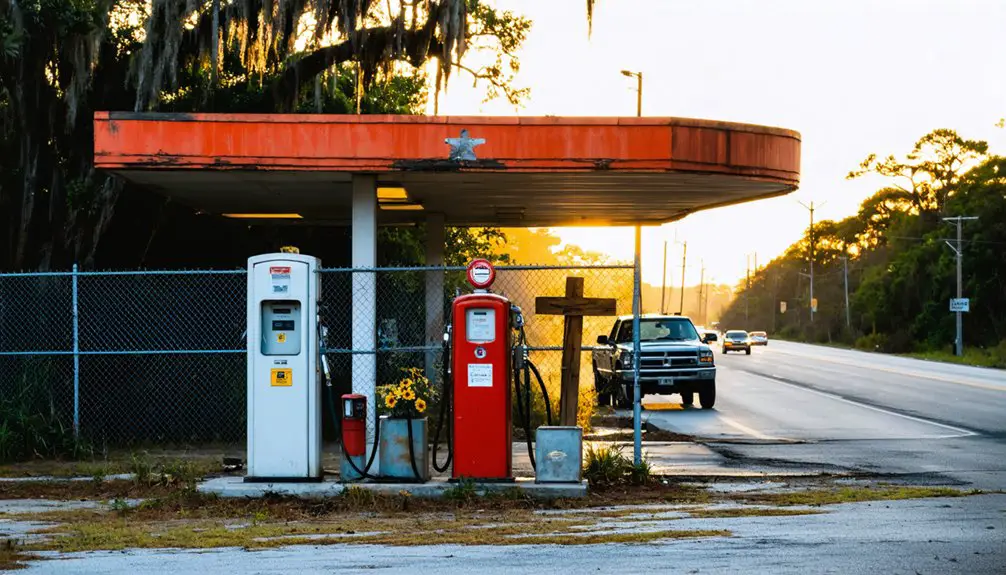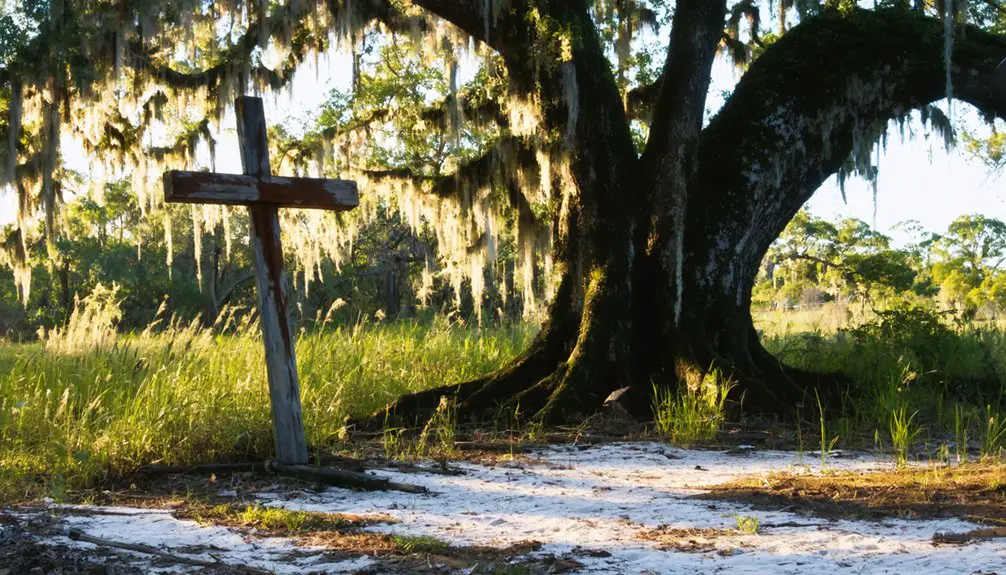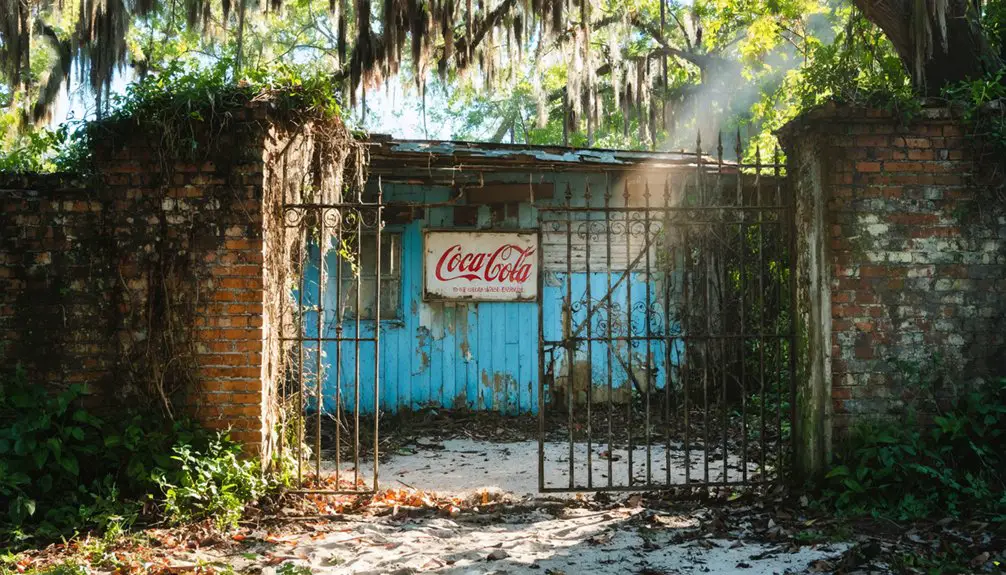You’ll find Espanola, Florida isn’t quite the ghost town some claim it to be. While this historic crossroads community has evolved from its 1880s origins and bustling Dixie Highway heyday, roughly 300 residents still call it home today. The descendants of founding families like the Hunters, Helms, and Raulersons maintain their agricultural traditions alongside a preserved 10-mile stretch of the original brick highway. This living proof of “Old Florida” holds more stories than first meets the eye.
Key Takeaways
- Espanola remains inhabited by approximately 300 residents despite being considered a ghost town due to its decline from peak prosperity.
- The town’s decline began when US-1 replaced the Dixie Highway in 1926, bypassing the once-bustling community.
- Historic remnants include a 10-mile stretch of original brick road from the Dixie Highway era, now on the National Register.
- Original founding families’ descendants still maintain agricultural traditions and land ownership in the area.
- The community actively preserves its rural character through conservation efforts and resistance to industrial development.
Origins of a Crossroads Community
While many Florida settlements emerged near waterways or existing transportation routes, Espanola began as a humble crossroads in 1880 with just three pioneering families – the Hunters, Helms, and Raulersons.
You’ll find their descendants still living in the area today, proof of the determination of these early settlers who faced significant transportation challenges. Without natural waterways, paved roads, or railroads initially, these families carved out their existence at this remote intersection. The arrival of the Florida East Coast Railway in the early 1890s finally brought new settlers to the growing community. The construction of the Old Brick Road in 1915 further connected this small community to major transportation routes.
The community’s evolution was tied to a stave mill operated by Lawrence Sidney Cody and Joseph Barrett Boaz, though debate still surrounds the settlement’s original name. Some say it was Raulerson, others claim Windermere – though that might be confused with nearby Lake Neoga, once called Lake Windermere.
The Rise and Fall of the Dixie Highway Era
Before the interstate system reshaped Florida’s landscape, the Dixie Highway transformed Espanola from an isolated crossroads into an important link between Chicago and Miami.
As travelers streamed south seeking sunshine and opportunity, your small town found itself at the heart of Florida’s early tourism boom. The economic impact rippled through the community as the red and white “DH” signs guided visitors to local businesses and services. Private organizations known as Auto Trail groups established and maintained these early routes through towns like Espanola. A section of the historic road running through Espanola was recognized when the Dixie Highway-Hastings, Espanola and Bunnell Road was added to the National Register of Historic Places in 2005.
Dixie Highway transformed sleepy towns into bustling stops along Florida’s tourism corridor, with DH signs beckoning travelers to local establishments.
- The original brick-paved sections of the highway served as Espanola’s lifeline to larger markets.
- Local politics guaranteed the town’s inclusion on the route, bringing crucial commerce to the area.
- Competition between towns for highway traffic reflected the high stakes of 1920s development.
- Though modern interstates eventually bypassed Espanola, you can still find preserved segments of the old road telling stories of its heyday.
Notable Founding Families and Their Legacy
You’ll find the Hunter, Helm, and Raulerson families at the heart of Espanola’s origins, as they established the first permanent settlement in the area by 1880.
These pioneering families created the foundation for what would become a growing community, particularly after the arrival of the railroad in the early 1890s brought the influential Deen family and other settlers. The town flourished with Irish potato farming and became an important agricultural center. The area later attracted tin-can tourists seeking camping grounds and services during the 1920s land boom.
It’s remarkable that descendants of those original three families still maintain their ancestral connections to Espanola’s land today, carrying forward their legacy despite the town’s eventual decline.
Early Pioneer Family Names
The pioneering spirit of Espanola’s founding families shaped this Florida settlement’s distinctive character in the late 19th century. You’ll find the Hunter, Helm, and Raulerson families among the earliest settlers who braved the undeveloped terrain around 1880. The families helped establish vital transportation routes when they supported building the Old Dixie Highway between 1914 and 1917.
The community ties grew stronger as the Karl Lord family took over the Aldrich Hunter place, establishing a thriving dairy operation, while the Deen brothers brought economic diversity through their turpentine enterprises in the early 1900s. George Moody followed his brother from Georgia to establish a successful turpentine business in 1904.
- Black pioneer families, including Rev. Frank Giddens’ ancestors, established a unique legacy of land ownership during segregation.
- The Harry Murray family contributed to nearby Neoga’s development, expanding regional settlement.
- The Moody family’s influence stretched from Espanola to Ocean City, now Flagler Beach.
- The Deen brothers’ arrival from Georgia sparked agricultural diversification with crops like potatoes and cabbage.
Generational Land Stewardship Today
Modern stewardship of Espanola’s ancestral lands reflects an evolving balance between preservation and progress, as current property owners maintain strict oversight of development pressures.
You’ll find today’s landowners committed to land conservation through permanent restrictions on industrial rezoning, protecting both ecosystems and residential quality of life.
While early pioneer families aren’t among current holders, today’s stewards honor their legacy through careful management of sizeable parcels.
They’ve pledged to resist heavy industrial development, preventing fuel depots and chemical processing facilities along key corridors.
Through community stewardship, they’re actively engaging with local government to monitor zoning proposals and preserve traditional land values.
Their efforts focus on sustainable development that doesn’t compromise heritage, even as they navigate economic pressures and infrastructure challenges facing the region.
The original proposal to convert 1,842 agricultural acres into industrial zones has sparked significant opposition from residents dedicated to preserving their rural way of life.
The area’s appeal is enhanced by its freshwater canal access, making it particularly attractive for residential development that aligns with conservation goals.
Historic Old Brick Road: A Living Monument
Standing as a proof of Florida’s early transportation ambitions, Espanola’s historic Old Brick Road emerged between 1914 and 1916 as part of an ambitious network connecting Miami to Montreal.
You can still drive on sections of this nine-foot-wide brick road near Bunnell, where red Graves bricks from Birmingham tell the story of Florida’s first rural paved highway. During its heyday, the road transformed Espanola’s economy, bringing 100-150 carloads of tourists daily and supporting thriving local businesses.
- Red bricks marked “GRAVES B’HAM, ALA” remain visible, offering a tangible connection to early road-building craftsmanship
- The narrow design accommodated Model T cars but limited passing opportunities
- Local settlers repurposed many original bricks for their homes and patios
- The road’s decline paralleled the rise of US-1 in 1926, leading to Espanola’s eventual ghost town status
The Mala Compra Plantation Story

You’ll find the story of Mala Compra Plantation woven into Florida’s early territorial period, where Joseph Hernandez established this 800-acre Sea Island cotton operation in 1816 through a Spanish land grant.
As Florida’s first Hispanic delegate to Congress and the influential figure who helped select Tallahassee as the state capital, Hernandez transformed what previous owners called a “bad purchase” into a thriving coastal plantation.
Your journey through Mala Compra’s history takes a dramatic turn in 1836 when Seminole forces burned the plantation during the Second Seminole War, leading Hernandez, who served as Brigadier General in the conflict, to abandon its reconstruction.
Early Days and Location
Located on Florida’s northeastern coast, the Mala Compra Plantation emerged from a Spanish land grant awarded to Joseph Hernández in 1816.
You’ll find this historic site at the meeting point of Graham’s Swamp and the Matanzas River’s southern headwaters, where coastal geography shaped its destiny. The property’s 700 acres of cultivated land proved ideal for agricultural practices, particularly cotton and sugarcane production, despite earlier settlers’ failures that earned it the name “bad bargain” in Spanish.
- The plantation sat on high hammock land dominated by Southern live oak
- Sandy white soil, though beach-like, displayed surprising fertility
- Buildings featured tabby floors and coquina block foundations
- The site neighbored the renowned Bulow Plantation Ruins State Park
Joseph Hernández’s Political Rise
From the fertile grounds of Mala Compra, Joseph Hernández cultivated not only Sea Island cotton but also a remarkable political career that would shape Florida’s early statehood.
You’ll find his rise to power deeply rooted in plantation economics, as his ownership of Mala Compra, Bella Vista, and St. Joseph plantations established him among Florida’s influential planter elite.
His political influence reached its pinnacle when he became Florida’s first Hispanic congressman, breaking barriers in American politics.
He’d go on to play a vital role in selecting Tallahassee as Florida’s capital city and serve as Brigadier General during the Second Seminole War.
The success of his agricultural enterprises, particularly the lucrative Sea Island cotton production at Mala Compra, provided the economic foundation that fueled his ascent in early Florida society.
War Brings Destruction
While Joseph Hernández’s political star was rising, dark clouds gathered over his prized Mala Compra plantation. As the Second Seminole War erupted in 1835, you’d have witnessed the transformation of this once-peaceful agricultural estate into a battleground of cultural resilience.
The Seminoles, fighting against displacement, burned the plantation in 1836, destroying the cotton warehouse and other structures. In the war’s aftermath, Hernández claimed losses of $99,000 – a devastating blow to his enterprise.
- U.S. Army seized the manor house, converting it into a military headquarters
- Plantation operations ceased as conflict disrupted slave labor and crop production
- Seminole raiders destroyed valuable livestock and agricultural stores
- The site became a temporary shelter for recaptured slaves amid the chaos
Life in Modern-Day Espanola

Despite its ghost town label, modern-day Espanola thrives as a small but vibrant community of roughly 300 residents who’ve maintained their rural lifestyle amid increasing development pressures.
You’ll find a tight-knit community nestled among dense Florida scrub pines, where residents proudly display their individuality through unique yard decorations and political signs. The historic red brick Dixie Highway serves as a physical reminder of the town’s heritage, with locals actively protecting it from souvenir hunters and modernization efforts.
While nearby developments threaten to bring thousands of new homes to the region, Espanola’s residents remain committed to preserving their quiet, secluded way of life.
In the face of encroaching suburbia, Espanola’s close-knit community stands firm in defense of their cherished rural traditions.
The town’s minimal signage and remote location help maintain its distinct character against the expanding urban sprawl of neighboring communities.
Early Transportation and Development
Before the arrival of the St. Johns & Halifax Railway in 1884, you’d find only scattered settlers in Espanola using primitive wagon trails for transportation. The railroad’s arrival sparked dramatic economic shifts, bringing jobs in turpentine, lumber, and rail sectors that drew over 100 residents by the 1890s.
The transportation evolution continued when the Dixie Highway arrived in 1915, featuring a distinctive nine-mile stretch of red brick pavement that you can still see today. This new road breathed fresh life into Espanola’s economy after the railroad’s decline.
- The narrow-gauge railway was converted to standard-gauge by Henry Flagler’s Florida East Coast Railway.
- African-American workers relocated here for industrial opportunities.
- Early wagon trails served pioneering families like the Hunters and Raulersons.
- The brick highway connected Jacksonville southward to Flagler Beach and Bunnell.
Frontier Conflicts and Settlement Challenges

Since Espanola lacked natural waterways and established transportation routes in the 1880s, you’d find the earliest settlers facing significant isolation and resource competition.
Pioneer families like the Hunters, Helms, and Raulersons carved out their existence amid dense North Florida scrub pine forests, where frontier disputes often arose over timber and turpentine resources.
You’d discover settlement difficulties intensified as families competed for limited economic opportunities in this remote outpost.
Without rail connections or navigable waterways, you were restricted to rough terrain and primitive roads for travel and trade.
The challenging landscape created a fragile existence where settlers faced constant environmental threats from wildfires and storms.
These early challenges would set the stage for Espanola’s vulnerability to later economic shifts and its eventual decline into near-ghost town status.
Preserving Local Heritage and Memory
While Espanola’s population has dwindled over the decades, you’ll find its heritage carefully preserved through both physical landmarks and community efforts. The local heritage preservation movement remains strong, with residents actively protecting sites like the historic Old Brick Road from development pressures.
You’ll notice unique touches of community engagement through dolphin-adorned mailboxes and yard displays that keep local traditions alive.
- The Flagler County Historical Society leads educational initiatives about the area’s rich history
- Protected sites like Bulow Plantation Ruins complement Espanola’s historical landscape
- Local content creators document and share the town’s heritage through digital storytelling
- Preservation regulations help balance modern development with protecting cultural landmarks
These combined efforts guarantee that Espanola’s story won’t fade into obscurity, despite the challenges of urbanization and time.
Land Use and Rural Character
You’ll find Espanola’s agricultural roots still evident in the scattered farms and old homesteads that dot the landscape, echoing the early cultivation of potatoes and cabbage by pioneering families like the Deens and Hollands.
The absence of major transportation routes has helped preserve the area’s rural character, with the narrow Old Dixie Highway remaining one of the few reminders of early 20th-century development.
Today, the surrounding undeveloped lands serve as both a reflection of conservation efforts and a living connection to the region’s resource-based past of turpentine production and timber harvesting.
Agricultural Heritage Lives On
Although Espanola’s bustling days have faded, its agricultural heritage remains deeply woven into the landscape through small family farms and historic homesteads.
You’ll find descendants of the Hunter, Helm, and Raulerson families still working the land, maintaining crop sustainability through methods passed down through generations. The area’s rural traditions endure in the quiet fields where potatoes and cabbage once flourished near the old turpentine stills.
- Original farming plots from the Florida Farms Development Company continue under family stewardship
- Traditional crop diversity reflects the adaptation to local soil conditions
- Small-scale agricultural operations preserve the “Old Florida” character
- Historic cattle ranching and turpentine harvesting practices shaped the current landscape
The bypass of U.S. Highway 1 inadvertently protected this agricultural legacy, allowing Espanola to maintain its authentic farming community spirit.
Conservation Shapes Modern Landscape
Since Espanola’s decline, conservation efforts have shaped its modern landscape into a reflection of rural Florida’s past.
You’ll find vast undeveloped spaces surrounding the historic infrastructure, particularly along the iconic Old Dixie Highway where a 10-mile stretch of original brick road still winds through the countryside.
Conservation impacts have preserved this rural identity by limiting development and urban sprawl.
You won’t see suburban sprawl or commercial centers here – instead, the land remains largely untouched, protected by its position in Florida’s “grey area” far from major cities.
While poor county GIS data makes precise land-use tracking difficult, you can witness how conservation practices maintain the region’s quiet character, keeping the natural environment intact and protecting historic features that tell the story of early Florida transportation.
Frequently Asked Questions
What Is the Current Population of Espanola?
While Española demographics aren’t officially tracked, you’ll find this ghost town’s population isn’t zero – it’s inhabited by likely fewer than 100 people, reflecting its history of decline from busier days.
Are There Any Stores or Businesses Operating in Espanola Today?
You won’t find any active businesses in Espanola today. The local commerce died out when Highway 1 bypassed the town, and the former hotel, restaurant, and other establishments have long since closed.
Can Visitors Access the Mala Compra Plantation Site Ruins?
Like stepping through time’s doorway, you’ll find Mala Compra’s plantation ruins completely accessible at Bing’s Landing Park. You’re free to explore the historic site via boardwalks anytime, without fees or restrictions.
What Happened to Espanola’s Original Post Office?
You’ll find Espanola’s original post office closed in 1955 after U.S. Highway 1 bypassed the town in 1926. This significant piece of Espanola history couldn’t survive the declining population and reduced mail business.
Do Any Churches or Schools Still Exist in Espanola?
You won’t find any active churches or schools in Espanola today. The church history and school legacy disappeared as the town declined, with residents now relying on nearby communities for these services.
References
- https://www.youtube.com/watch?v=HLUVRWqGxJU
- https://flaglercountyhistoricalsociety.com/historic-locations-in-flagler-county/
- https://www.florida-backroads-travel.com/espanola-florida-old-brick-road.html
- https://flaglercountyhistoricalsociety.com/espanola/
- https://www.atlasobscura.com/places/the-old-brick-road-florida
- https://www.observerlocalnews.com/news/2022/jun/11/flagler-county-at-a-crossroads-community-or-concrete-jungle/
- https://www.flaglersheriff.com/about-us/history-of-flagler-county
- https://flaglerlive.com/bunnell-history-celebration-2025/
- https://en.wikipedia.org/wiki/Dixie_Highway
- https://ridgehistory.org/part_1_dixie_hwy.html



